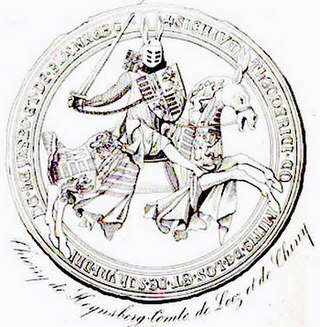Related Research Articles

The County of Loon was a county in the Holy Roman Empire, which corresponded approximately with the modern Belgian province of Limburg. It was named after the original seat of its count, Loon, which is today called Borgloon. During the middle ages the counts moved their court to a more central position in Kuringen, which today forms part of Hasselt, capital of the province.
The County of Verdun was a sovereign medieval county in the Duchy of Lower Lorraine.

The Prince-Bishopric of Verdun was a state of the Holy Roman Empire. It was located at the western edge of the Empire and was bordered by France, the Duchy of Luxembourg, and the Duchy of Bar. Some time in the late 990s, the suzerainty of the County of Verdun passed from Herman of Ename of the House of Ardenne–Verdun to the Bishopric of Verdun.
Otto I(Eudes) (died 987), Count of Chiny, perhaps son of Adalbert I the Pious, Count of Vermandois, and Gerberge of Lorraine. Although he probably did not use the title, Otto is regarded as the first Count of Chiny.
Louis I, Count of Chiny (987–1025) and Count of Verdun (1024–1025), son of Otto I, Count of Chiny, and an unknown mother.
Louis II, Count of Chiny, son of Louis I, Count of Chiny and Verdun, and Adélaïde de Saint Varme. He left very few traces in history and nothing is known about his reign.
Arnold I, Count of Chiny, son of Louis II, Count of Chiny, and his wife Sophie. He succeeded his father as count before 1066.
Otto II, Count of Chiny, son of Arnold I, Count of Chiny, and Adélaïs.
Albert (Albert I) (before 1131 – 29 September 1162), Count of Chiny, son of Otto II, Count of Chiny, and Adélaïs of Namur. He succeeded his father before 1131 and spent most of his time in Chiny, not taking part in the various conflicts which shook the region.
Louis IV the Young, count of Chiny from 1189 to 1226, son of Louis III, count of Chiny, and Sophie. Louis was the last of the first dynasty of counts of Chiny. Having no son, he prepared his eldest daughter Jeanne as his successor. Louis marked his reign by issuing the first postage stamp in the county.
Joan was the Countess of Chiny. Joan was the daughter of Louis IV, Count of Chiny, and Matilda of Avesnes, and became ruler of the county upon her father’s death on 7 October 1226. She married Arnold IV, Count of Loon, son of Gerard III, Count of Rieneck, and Kunigunde von Zimmern, in 1228, whereupon he assumed the role of Count of Chiny.
John I (Jean) (d. 1278 or 1279), Count of Looz and Count of Chiny, eldest son of Arnold IV, Count of Looz and Chiny, and Jeanne, Countess of Chiny. He succeeded his father in 1272 or 1273, as the Count of Looz and Chiny. Virtually nothing is known about his reign.
Louis V (1235–1299), Count of Chiny from 1268–1299, the youngest son of Arnold IV, Count of Looz and Chiny, and Jeanne, Countess of Chiny. He became Count of Chiny in 1268 when his parents entrusted him with the county before their death.

Arnold V de Looz, was Count of Loon from 1279 to 1323 and Count of Chiny from 1299 to 1310. He was the son of John I, Count of Looz and Mathilde Jülich.
Louis IV, Count of Looz (1323-1336) and Count of Chiny (1313-1336), son of Arnold V, Count of Looz and Chiny, and Marguerite Vianden.

Diederik of Heinsberg was the Count of Loon and Count of Chiny (1336–1361).
Godfrey de Heinsberg, Lord of Daelenbroeck, Count of Looz and Count of Chiny (1361–1362), son of John of Heinsberg, Lord of Daelenbroeck.
Arnold VI de Rumigny, Count of Looz and Count of Chiny (1362–1364), son of William of Oreye, Lord of Rumigny, and Jeanne de Looz, daughter of Arnold V, Count of Loon and Chiny, and, Marguerite Vianden, Lady of Perwez and Grimbergen.

John II of Loon, Lord of Jülich, Heinsberg and Löwenberg, son of Godfrey de Heinsberg, Count of Looz, and Philippa of Jülich, daughter of William V, Duke of Jülich, and Joanna of Hainaut. Although John was the first son of Godfrey, he did not inherit the countship of Looz, the title instead going to Arnold of Rumingy.

The Tournament of Chauvency was held in 1285 to bring together the greatest knights of France and Germany for six days of jousting and other activities, a social event of primary importance at the end of the thirteenth century. Dedicated to Henry IV, Count of Salm, the tournament was organized by Louis V, Count of Chiny, and held in the small village of Chauvency-le-Château, near Montmédy.
References
- ↑ Vanderkindere, L. (1899). Histoire de la formation territoriale des principautés belges au moyen âge. Bruxelles: Hayez.
- ↑ Brooke, Z. N. (Zachary Nugent)., Previté-Orton, C. W. (Charles William)., Tanner, J. R. (Joseph Robson)., Whitney, J. Pounder., Gwatkin, H. Melvill., Bury, J. B. (John Bagnell). (19111936). The Cambridge medieval history. New York: Macmillan. Volume III.
- ↑ Jeantin, J. François Louis. (185859). Histoire du comté de Chiny et des pays haut-wallons. Paris: J. Tardieu.
- Bury, J. B. (Editor), The Cambridge Medieval History, Volume III. Germany and the Western Empire, Cambridge University Press, 1922.
- Dupont, Christian; Laret-Kayser, Arlette (1979), "A propos des comtés post-carolingiens: les exemples d'Ivoux et de Bastogne", Revue belge de philologie et d'histoire, 57: 805–823, doi:10.3406/rbph.1979.3258
- Laret-Kayser, Arlette (1986), Entre Bar et Luxembourg : Le Comté de Chiny des Origines à 1300, Collection Histoire, série in-8°, n° 72), Brussels: éditions du Crédit Communal
- Settipani, Christian, La Préhistoire des Capétiens (Nouvelle histoire généalogique de l'auguste maison de France, vol. 1), Villeneuve d'Ascq, éd. Patrick van Kerrebrouck, 1993, 545 p.
- Vanderkindere, Léon, La Formation territoriale des principautés belges au Moyen Âge, Bruxelles, H. Lamertin, 1902